Motorhome travel: The wonder of Wales
Words and photos: Joyce Hopewell
Additional photos from Alamy Stock Photo
Driving through superb mountainous scenery, enjoying wide vistas as we navigate hairpin bends and plunge into cool, green, wooded tunnels, I have to keep reminding myself of where we are.
We could be in the Swiss Jura, the Black Forest or France’s Massif Central. But no, this is the Brecon Beacons National Park in Wales and it’s superb.
We’d come this way before, as a Mum ‘n’ Dad taxi service when our daughter was at university in south Wales, but we hadn’t taken time to look around. This trip would be different; we’d explore mid-Wales and the Beacons, stopping off in some of the smaller towns along the way.
Travelling from home in Cheshire on a sparkling summer’s day, I appreciate less familiar parts of the county. Neighbouring Shropshire is equally bucolic, with the pace of life more laid back.
The Old Station in Welshpool makes a good stopping place. Converted into a tourist attraction, with a café and shops housed within the structure of the original building, there’s parking and toilets.
A quick browse is irresistible, but we’d come to see the town’s Tudor and Victorian buildings. On a Sunday all is quiet, the high street dominated by the ornate town hall and decorated by a number of sixteenth century timber-framed buildings. We give nearby Powis Castle a miss, mainly because we have our puppy, Bosworth, with us on his first big trip and there is nowhere dog friendly within the castle precincts.
As we park in our next small town, Llanidloes, I hear swifts screaming overhead as they dart in and out of nesting boxes under the eaves of a pub. Llanidloes has a few gems: the sixteenth century Old Market Hall at the crossroads in the centre is an attractive timber-framed building and home to an exhibition of similar buildings in the area.
The curator is closing just as we arrive, but she offers to stay open so that we can look around. She gives us a quick summary of what to see in town. Bosworth is welcomed, too. In the cobbled area beneath the market hall we chat to one of the locals and find the John Wesley stone at one end. A plaque describes how Wesley preached here in the late 1700s; he really got about a bit because there’s a similar stone in our home town!
The nearby Trewythen Hotel has a plaque commemorating the storming of the building in 1839 by the Chartists, demanding political rights and influence for the working classes. It’s hard to imagine a riot in this sleepy town.
In St Idloes Church, recommended by our curator friend, we find the hammerbeam ‘Angel Roof’ and pillars and arches taken from the Cistercian abbey at Cwmhir after its dissolution in 1536.
Heading for the Elan Valley near Rhayader we have spectacular sightings of a large group of red kites as they fly low across the quiet country road. They are following a tractor ploughing in an adjacent field. We stop, enthralled to see these magnificent birds at such close quarters.
That night, staying at Elan Oaks Camping and Caravan Site, Jupiter, Mars and the Plough – along with millions of stars – appear overhead as the sky slowly darkens. I grab my binoculars and stay out stargazing until my neck is stiff. The Brecon Beacons National Park is one of only 11 members of the International Dark-Sky Association.
Next day, we explore the four Elan Valley reservoirs, created in the late 1800s to supply water to industrial Birmingham. An eight-mile wheelchair-accessible trail covers all viewpoints of the dams and lakes.
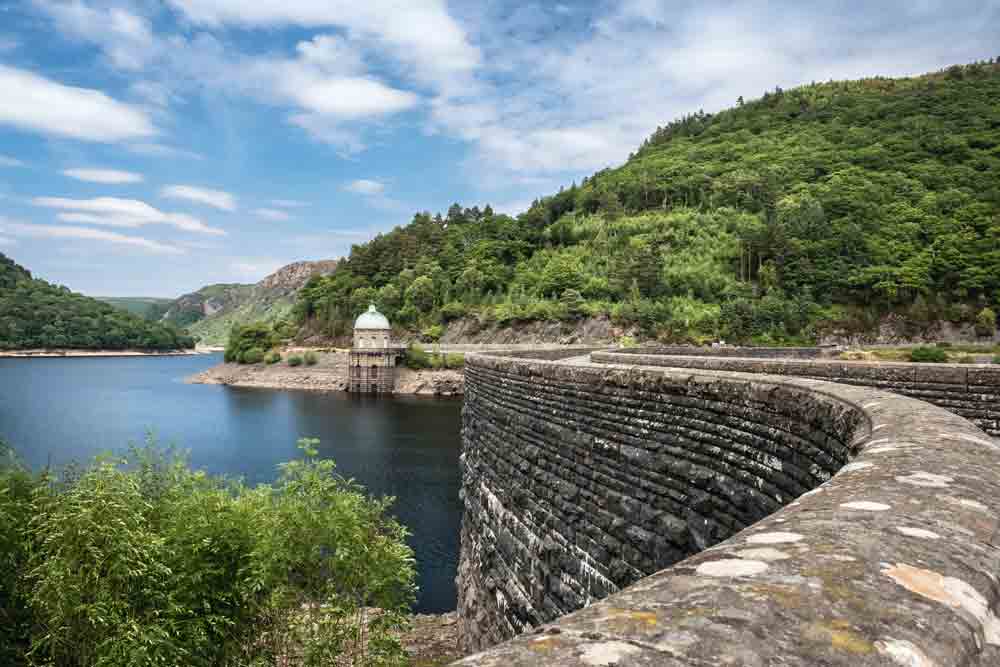
From the visitor centre we walk some of the trail then swap to the motorhome to visit all four lakes. Bosworth has lots of walks that day as we park and walk to each dam.
We divert along a sun-dappled riverside path and peer up at the sheer wall of one dam, topped by a Victorian green-domed building. We learn that, in 1942, secret operations were underway at the now-disused Nant-y-Gro dam when the Barnes Wallis bouncing bomb was tested there.
Wondering if the scenery can get any better, we drive through the heart of Wales next day, taking quiet winding routes (which were OK for our campervan’s length). We’re heading for Llanwrtyd Wells, which claims to be the smallest town in Britain.
Yes, it’s small and quiet, but in August it comes alive when it hosts the World Alternative Games. Egg throwing, finger jousting and snail racing take place alongside gravy wrestling and bog snorkelling. I was rather drawn to the husband-dragging event; just as well we were there in July!
We park and walk into the centre hoping for coffee. All three cafés appear to be closed. Caffi Sosban near the bridge has a ‘closed’ sign displayed prominently outside, yet there are people inside. Someone has forgotten to turn the sign around. We go in – Bosworth is welcome – and have coffee and Welsh cakes. We chat with a friendly local about their wacky races.
Llandovery appears large by comparison, with craft and antique shops and a motte and bailey castle ruin overlooking the town. We park by the castle and clamber to the top of the mound. A modern sculpture of Llywelyn ap Gruffydd, Wales’s ‘Braveheart’, is at the foot of the mound. His empty helmet with its dark interior reminds me of Darth Vader.
We stay near Brecon, but give the town itself a miss, choosing instead to visit the waterfalls at Ystradfellte. Surrounded by the Beacons’ peaks, we drive along narrow, twisty roads with passing places.
We cross wide, empty moorland where we find Maen Llia, a large standing stone. Estimated to be 4,000 years old, the stone may be a boundary marker. Legend says it walks towards the river for a drink on midsummer’s eve.
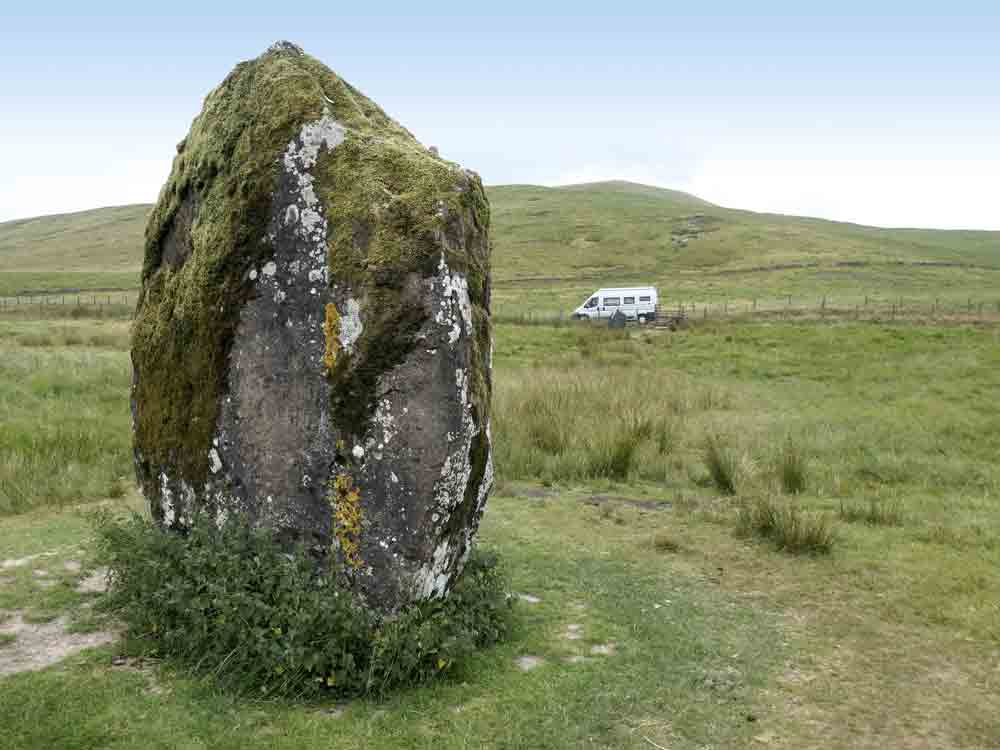
From the car park at the start of the Four Falls Trail we walk to White Meadow Fall. The trail is easy to begin with, but gets rougher and more challenging nearer the waterfall. We see wheatears along the way and the paths are lined with banks of purple rose bay willow herb.
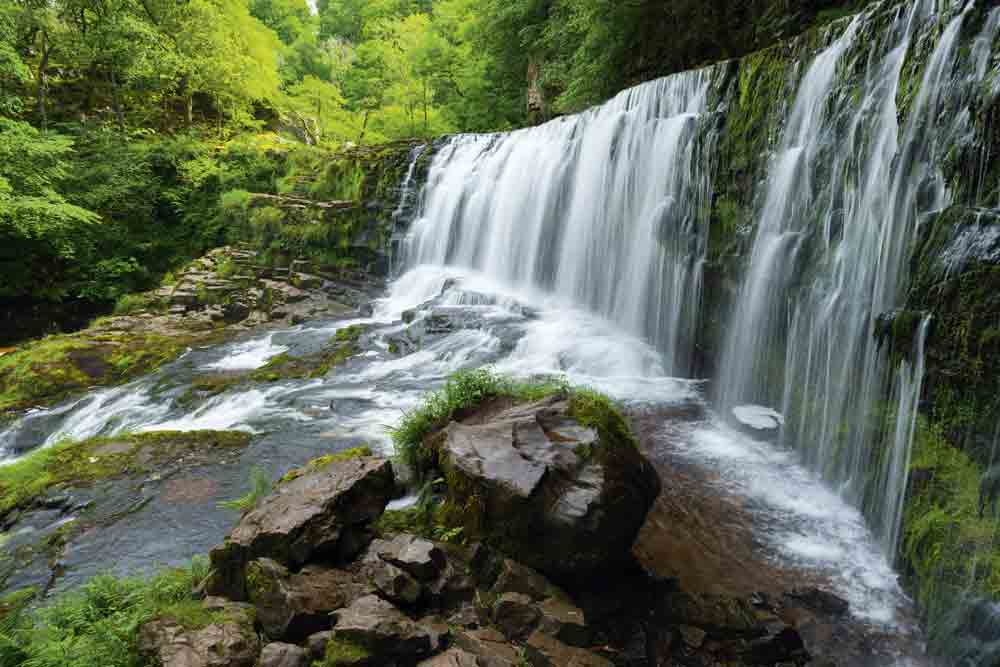
We hear shrieks and shouting as the waterfall comes into view; a teenage outward-bound group in full wetsuit gear and helmets are taking it in turn to jump into the pool at the top.
We consider walking on to the next fall, but an information board makes it clear that the going gets tougher. With a cup of tea and a slice of cake in mind, returning to the motorhome is suddenly a very desirable option!
We head off into the Black Mountains on our way to Crickhowell. Arriving at lunch time, we head to the Courtroom Café, which provides cheerful service and welcomes dogs. Crickhowell is lively and busy with tourists. Set against the backdrop of Crug Hywel (aka Table Mountain), it’s an attractive place to explore, with independent shops and a characterful terrace of old houses leading down to the eighteenth century bridge – the longest stone bridge in Wales. It’s said to have 12 arches on one side and 13 on the other.
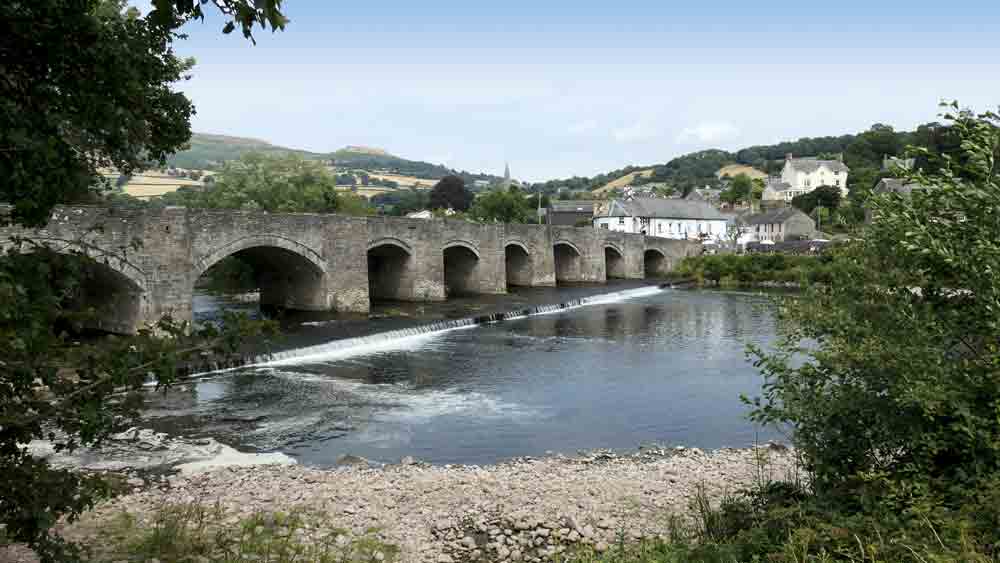
I’d been looking forward to seeing the World Heritage Blaenavon Ironworks. Entry is free, dogs are welcome and a self-guided tour leaflet is provided. The curator offered additional information and we lost track of time exploring this fascinating historic site.
Blaenavon Ironworks, founded in 1787, played a significant role in the Industrial Revolution. Coal, limestone and iron ore from the surrounding area provided the ingredients for the production of iron.
‘Welcome to Hell’ is the oft-seen greeting on numerous information boards – an apt and chilling description of what life was like for those who worked and lived here. Hellish, hot and unhealthy it was, with intensely hot furnaces and toxic air. Many of the workers didn’t live much beyond the age of 30.
We drive next day to Llanthony Priory, which is somewhere out in the scenic sticks. We follow more twisty roads with passing places and are soothed by the green surroundings that enfold the priory ruins and the small church of St David.
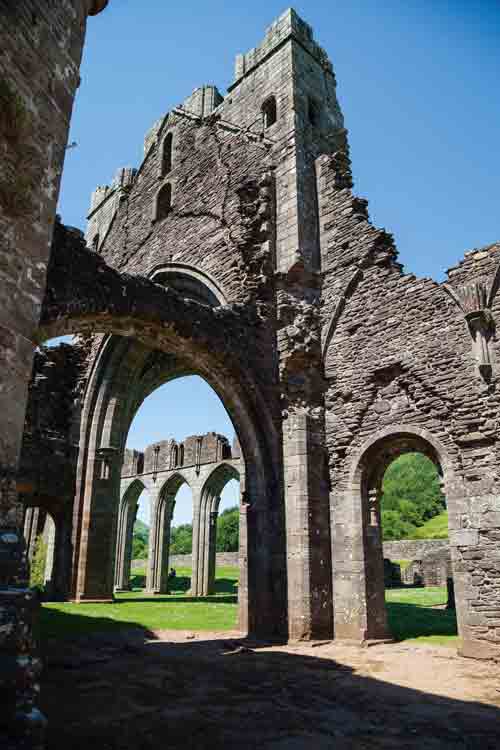
With plenty of nearby walks I take Bosworth to explore while Barry goes into the priory grounds (no dogs). We swap over and I get my quiet time in the ruins, enjoying the spectacular views, the ambience and the idyllic setting.
We drive up and over Gospel Pass to the top of the Black Mountains. The drive is hairy, the road narrow but, at the top, we see for miles in all directions and wild ponies wander about, ignoring the walkers and cars.
Dropping down into Hay-on-Wye we can’t resist a quick browse in a couple of the many secondhand bookshops. I find a bookseller’s sign – Boz Books – which makes me smile; our dog is called Boz for short.
We head for Llandrindod Wells, which has an air of faded genteel elegance, with several pleasant parks. Exploring the Rock Park we find attractive densely wooded areas and the chalybeate spring housed in a pink marble fountain with drinking cup.
Seeing red kites every day on this trip never failed to lift our spirits. At Gigrin Farm feeding station near Rhayader I wondered if we’d left the best until last as we saw several hundred kites feeding and flying.
Homeward bound, we find the ruins of Abbey Cwmhir, whose arches and pillars we had seen in St Idloes Church. There’s not much of the abbey left, but we get a sense of its size and length as the cattle graze contentedly amongst its crumbling walls.
We head home, having seen so much, yet with much still unexplored in this vast and glorious Welsh countryside.
This article was originally published in the July 2019 issue of MMM. Click here to buy a digital edition of the magazine.








Recent Updates
Engine management lights: all you need to know
What is the engine management light? What does it mean, and what do I have to do? ...
Motorhome air suspension: all you need to know
Motorhomes are heavy and the additional weight of equipment and height of the bodywork can increase the loads ...
Motorhome WiFi: how to get better motorhome internet
Staying connected on the move is more and more essential, so relying on campsite WiFi isn't an option – here ...
A class of their own - our guide to A-class motorhomes
Thinking of trading up to an A-class, or even going straight to the top of the motorhome tree? We guide you ...
Explore overseas on a motorhome dream tour
Enjoy exotic travel in a campervan or motorhome by hiring, swapping with someone else or exporting your ...
Motorhome water systems: everything you need to know
On-board water is an important part of every motorhome – here’s everything you need to know ...
Campervanning in Europe: what you need to know
Whether you're planning a leisurely drive through the French countryside, navigating bustling city streets in ...
Campervan security: all you need to know
With thefts on the increase, it’s important to know how to keep your campervan secure and prevent campervan ...
Campervan furniture: everything you need to know
Our campervan experts guide you through all the essentials for your campervan, including tables, chairs, ...
Campervan finance: how to fund your purchase
Here we look at the different types of campervan finance available, to help you decide what’s the best option ...
Other Articles
Britain’s best used motorhomes
Want a great motorhome without paying the premium for a new one? Here's a guide to the best you can get in the pre-owned market for each layout, ...
Which motorhome? Choosing the perfect motorhome for you
Choosing a motorhome or campervan is one of the biggest buying decisions you’ll ever make, so it's important ...
Campervan washroom essentials: stay fresh on the road
Our guide will take you through the campervan washroom essentials you'll need so you're well-prepared for ...
Dogs in campervans: all you need to know
Follow our advice and your dog will enjoy campervanning as much as you do ...
Electric campervans: all you need to know
Our guide will take you through everything you need to know about electric campervans and what the future ...
Motorhome electrics: a complete guide to your motorhome electrical set-up
Motorhome electrics can dramatically enhance the convenience and comfort of your vehicle – but they can be ...
Lighting for campervans: all you need to know
We guide you through all the lighting options available for you and your campervan, including interior ...
Electric bikes for motorhomes: our ultimate guide
Read our comprehensive guide to electric bikes for motorhome owners, helping you add electric power to your ...
Our guide to 'cheap' motorhomes in 2024
If you're on the hunt for an affordable new motorhome, this is the best place to start – we've rounded up a ...
Campervans in winter: all you need to know
Here's your guide to preparing your campervan for the colder months, whether you will be using it or putting ...